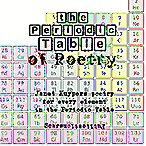



|
enjoy this writing from Janet Kuypers in the cc&d free 2014 PDF file chapbook: Crossing Borders for International (and Interplanetary) Peace of Periodic Table poems performed live 10/9/14 at Chicago’s Cup & Spoon. Click the title or the cover to download the free PDF file chapbook. |

|
|
Order this writing in the book One Solitary Word the cc&d July - Dec. 2014 collection book |
 |
get the 402 page July - Dec. 2014 cc&d magazine issue collection 6" x 9" ISBN# paperback book: |
| ||
|
Order this writing in the poetry book by Janet Kuypers with poetry for every element in the Periodic Table: the Periodic Table of Poetry Order this 8.5" x 8.5" ISBN# book today: |

|
|
| |
![]()




